Related Research Articles

Zeus is the sky and thunder god in ancient Greek religion and mythology, who rules as king of the gods on Mount Olympus. His name is cognate with the first syllable of his Roman equivalent Jupiter.

The Minoan civilization was a Bronze Age culture which was centered on the island of Crete. Known for its monumental architecture and its energetic art, it is often regarded as the first civilization in Europe.

Britomartis was a Greek goddess of mountains and hunting, who was primarily worshipped on the island of Crete. She was sometimes believed to be an oread, or a mountain nymph, but she was often conflated or syncretized with Artemis and Aphaea, the "invisible" patroness of Aegina. She is also known as Dictynna or as a daughter of Dictynna.

Eileithyia or Ilithyia was the Greek goddess of childbirth and midwifery, and the daughter of Zeus and Hera. In the cave of Amnisos (Crete) she was related with the annual birth of the divine child, and her cult is connected with Enesidaon, who was the chthonic aspect of the god Poseidon. It is possible that her cult is related with the cult of Eleusis. In his Seventh Nemean Ode, Pindar refers to her as the maid to or seated beside the Moirai (Fates) and responsible for the creation of offspring. Her son was Sosipolis, who was worshiped at Elis.

In Greek mythology, the Cretan Bull was the bull Pasiphaë fell in love with, giving birth to the Minotaur.

Labrys is, according to Plutarch, the Lydian word for the double-bitted axe. In Greek it was called πέλεκυς (pélekys). The plural of labrys is labryes (λάβρυες).
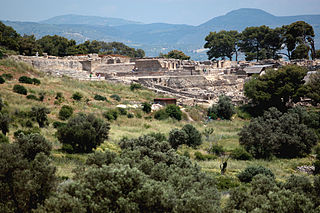
Phaistos ), also transliterated as Phaestos, Festos and Latin Phaestus, is a Bronze Age archaeological site at modern Faistos, a municipality in south central Crete. It is notable for the remains of a Minoan palace and the surrounding town.

Hieros gamos, hieros (ἱερός) meaning "holy" or "sacred" and gamos (γάμος) meaning "marriage," or Hierogamy, is a sacred marriage that plays out between gods, especially when enacted in a symbolic ritual where human participants represent the deities.

Gortyn, Gortys or Gortyna is a municipality, and an archaeological site, on the Mediterranean island of Crete 45 km (28 mi) away from the island's capital, Heraklion. The seat of the municipality is the village Agioi Deka. Gortyn was the Roman capital of Creta et Cyrenaica. The area was first inhabited around 7000 BC.

Gortyna was a town of ancient Crete which appears in the Homeric poems under the form of Γορτύν; but afterwards became usually Gortyna (Γόρτυνα). According to Stephanus of Byzantium it was originally called Larissa (Λάρισσα) and Cremnia or Kremnia (Κρήμνια).

Psychro Cave is an ancient Minoan sacred cave in Lasithi plateau in the Lasithi district of eastern Crete. Psychro is associated with the Diktaean Cave, one of the putative sites of the birth of Zeus. Other legends place Zeus' birthplace as Idaean Cave on Mount Ida. According to Hesiod, Theogony, Rhea gave birth to Zeus in Lyctus and hid him in a cave of Mount Aegaeon. Since the late nineteenth century the cave above the modern village of Psychro has been identified with Diktaean Cave, although there are other candidates, especially a cave above Palaikastro on Mount Petsofas.
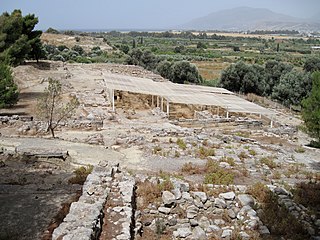
Hagia Triada is a Minoan archaeological site in Crete. The site includes the remains of an extensive settlement as well as a large structure known as the Royal Villa. It is located in the Mesara Plain near the Palace of Phaistos, with which it appears to have had close political and economic ties. Excavations at Hagia Triada have provided crucial evidence concerning Minoan everyday life. Notable finds include the Hagia Triada sarcophagus, the "Harvester Vase", and the largest cache of Linear A tablets found at any Minoan site.
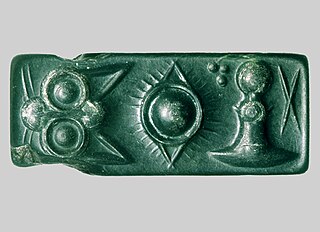
Cretan hieroglyphs are a hieroglyphic writing system used in early Bronze Age Crete, during the Minoan era. They predate Linear A by about a century, but the two writing systems continued to be used in parallel for most of their history. As of 2024, they are undeciphered.

The Heraklion Archaeological Museum is a museum located in Heraklion on Crete. It is one of the largest museums in Greece and the best in the world for Minoan art, as it contains by far the most important and complete collection of artefacts of the Minoan civilization of Crete. It is normally referred to scholarship in English as "AMH", a form still sometimes used by the museum in itself.

Two Minoan snake goddess figurines were excavated in 1903 in the Minoan palace at Knossos in the Greek island of Crete. The decades-long excavation programme led by the English archaeologist Arthur Evans greatly expanded knowledge and awareness of the Bronze Age Minoan civilization, but Evans has subsequently been criticised for overstatements and excessively speculative ideas, both in terms of his "restoration" of specific objects, including the most famous of these figures, and the ideas about the Minoans he drew from the archaeology. The figures are now on display at the Heraklion Archaeological Museum (AMH).

Minoan religion was the religion of the Bronze Age Minoan civilization of Crete. In the absence of readable texts from most of the period, modern scholars have reconstructed it almost totally on the basis of archaeological evidence of such as Minoan paintings, statuettes, vessels for rituals and seals and rings. Minoan religion is considered to have been closely related to Near Eastern ancient religions, and its central deity is generally agreed to have been a goddess, although a number of deities are now generally thought to have been worshipped. Prominent Minoan sacred symbols include the bull and the horns of consecration, the labrys double-headed axe, and possibly the serpent.
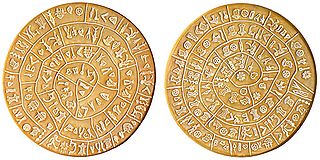
The Italian School of Archaeology at Athens is one of the 19 foreign archaeological institutes headquartered in Athens, Greece, with branch offices in Crete, Limnos and Rome.
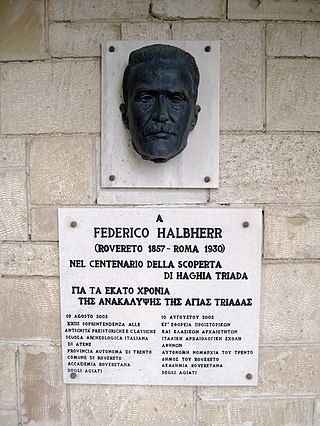
Federico Halbherr was an Italian archaeologist and epigrapher, known for his excavations on Crete. In particular, he is known for his excavations of the Minoan palace at Phaistos and the Minoan town of Hagia Triada. A contemporary, friend, and advisor of Arthur Evans, he began excavating at Phaistos before Evans began excavating at Knossos. Some of his work was funded by the Archaeological Institute of America.
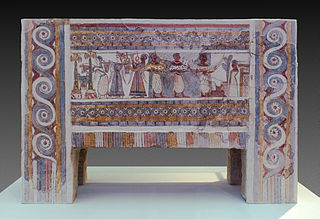
The Hagia Triada Sarcophagus is a late Minoan 137 cm (54 in)-long limestone sarcophagus, dated to around 1400 BC or some decades later, excavated from a chamber tomb at Hagia Triada, Crete in 1903 and now on display at the Heraklion Archaeological Museum (AMH) in Crete, Greece.

The name poppy goddess is often used for a famous example of a distinctive type of large female terracotta figurine in Minoan art, presumably representing a goddess, but not thought to be cult images, rather votive offerings. It was discovered in a sanctuary of the Post-palace period at Gazi, Crete, and is now in the Heraklion Archaeological Museum.
References
- ↑ Al 1944, pp. 215.
- ↑ Al 1944, pp. 216–217.
- ↑ Dietrich 1974, pp. 11.
- ↑ Castleden 1990, p. 29.
- 1 2 Al 1944, p. 219.
- ↑ Kouremenos 2018, pp. 55.
- ↑ D'Agata 1995, pp. 24.
- ↑ Sanders 1976, pp. 133.
- ↑ D'Agata 1995, pp. 25.
- ↑ Kouremenos 2016, pp. 47.
- ↑ Hadzisteliou Price 1978, pp. 84.
- ↑ Dietrich 1974, pp. 16.
- ↑ El-Khashab 1984, pp. 215.
- ↑ Cook 1908, pp. 413.
- ↑ Dietrich 1967, pp. 408.
- ↑ Dietrich 1974, pp. 15.
- ↑ Rose 1934, pp. 42.
Bibliography
- Al, B. (1944). "Cretan Religion in Relation to Greek Religion". Mnemosyne . Brill Publishers. 12 (3): 208–222.
- Castleden, Rodney (1990). "The people: Social structure". Minoans: Life in Bronze Age Crete. Routledge. ISBN 978-0415088336.
- Cook, Arthur Bernard (1903). "Zeus, Jupiter and the Oak". The Classical Review. Cambridge University Press. 17 (8): 403–421. doi:10.1017/S0009840X00325550. S2CID 161390689.
- D'Agata, Anna Lucia (1995). "Changing Patterns in a Minoan and Post-Minoan Sanctuary: the Case of Agia Triada". British School at Athens Studies. British School at Athens. 2: 19–26.
- Dietrich, Bernard Clive (1974). The Origins of Greek Religion. Berlin, Germany: Walter de Gruyter. ISBN 978-3110039825.
- Dietrich, Bernard Clive (1967). "Some Light from the East on Cretan Cult Practice". Historia: Zeitschrift für Alte Geschichte. 6 (4): 385–413.
- El-Khashab, Abd El-Mohse (1984). "The Cocks, the Cat, and the Chariot of the Sun". Zeitschrift für Papyrologie und Epigraphik. 55: 215–222.
- Kouremenos, Anna (2016). "The double axe (λάβρυς) in Roman Crete and beyond: the iconography of a multi-faceted symbol". In Francis, Jane E.; Kouremenos, Anna (eds.). Roman Crete: New Perspectives. Oxbow Books. pp. 43–57. ISBN 978-1785700958.
- Kouremenos, Anna (2018). "In the Heart of the Wine-Dark Sea: Insularity and Identity in the Roman Period". Insularity and identity in the Roman Mediterranean. Oxbow Books. pp. 41–64. ISBN 978-1785705809.
- Hadzisteliou Price, Theodora (1978). Kourotrophos: Cults and Representations of the Greek Nursing Deities. Leiden, Netherlands: Brill Publishers. ISBN 978-9004052512.
- Rose, H. J. (1934). "Altheim: Revolutionary or Reactionary?". The Harvard Theological Review. Cambridge University Press. 27 (1): 33–51. doi:10.1017/S0017816000021386. S2CID 161636302.
- Sanders, I. F. (1976). "Settlement in the Hellenistic and Roman Periods on the Plain of the Mesara, Crete". The Annual of the British School at Athens. British School at Athens. 71: 131–137. doi:10.1017/S0068245400005840. S2CID 130930642.